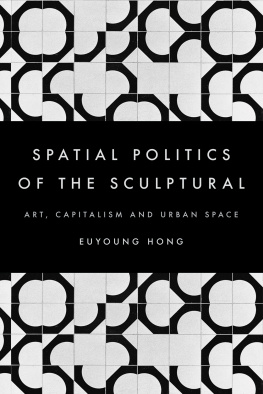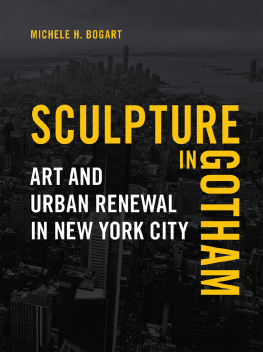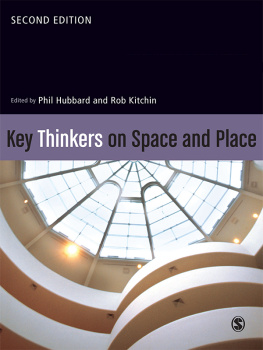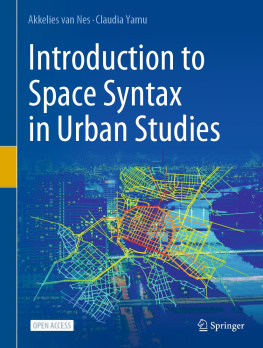The Spatial Politics of the Sculptural
The Spatial Politics of the Sculptural
Art, Capitalism and the Urban Space
Euyoung Hong

London New York
Published by Rowman & Littlefield International, Ltd.
Unit A, Whitacre Mews, 26-34 Stannary Street, London SE11 4AB
www.rowmaninternational.com
Rowman & Littlefield International, Ltd. is an affiliate of Rowman & Littlefield
4501 Forbes Boulevard, Suite 200, Lanham, Maryland 20706, USA
With additional offices in Boulder, New York, Toronto (Canada), and Plymouth (UK)
www.rowman.com
Copyright 2016 by Euyoung Hong
All rights reserved . No part of this book may be reproduced in any form or by any electronic or mechanical means, including information storage and retrieval systems, without written permission from the publisher, except by a reviewer who may quote passages in a review.
British Library Cataloguing in Publication Data
A catalogue record for this book is available from the British Library
ISBN: HB: 978-1-7834-8759-2
PB: 978-1-7834-8760-8
Library of Congress Cataloging-in-Publication Data
Name: Hong, Euyoung, 1975 author.
Title: The spatial politics of the sculptural : art, capitalism and the urban space / Euyoung Hong.
Description: New York : Rowman & Littlefield International, 2016. | Includes bibliographical references and index.
Identifiers: LCCN 2016020905 (print) | LCCN 2016021150 (ebook) | ISBN 9781783487592 (cloth : alk. paper) | ISBN 9781783487608 (pbk. : alk. paper) | ISBN 9781783487615 (electronic)
Subjects: LCSH: SculpturePhilosophy. | Social ecology.
Classification: LCC NB1135 .H66 2016 (print) | LCC NB1135 (ebook) | DDC 730.1dc23
LC record available at https://lccn.loc.gov/2016020905
 The paper used in this publication meets the minimum requirements of American National Standard for Information SciencesPermanence of Paper for Printed Library Materials, ANSI/NISO Z39.48-1992.
The paper used in this publication meets the minimum requirements of American National Standard for Information SciencesPermanence of Paper for Printed Library Materials, ANSI/NISO Z39.48-1992.
Printed in the United States of America
Contents
Figures
Tables
I would like to thank all those who helped me with the preparation of the manuscript. The staff at Rowman & Littlefield International has always been supportive and encouraging of my project. I would also like to thank artists, galleries, foundations and museums who provided images and resources, specifically Kyuchul Ahn, Galerie Lelong, New York; LWL-Museum fr Kunst und Kultur, Mnster; Foksal Gallery Foundation, Warszawa; and Hauser & Wirth, London.
In the late 1980s, the South Korean government decided to initiate a massive housing construction plan, the Two Million Home Construction Plan, as a solution for improving problems of severe housing shortages and to stabilize housing prices. Compared with other developed countries, the process of South Korean urbanization, particularly in such a restricted metropolitan area of Seoul, has been extremely violent, exclusive, mass-produced and standardized. In many cases, not only was it accompanied by destructive methods of forced displacement and relocation in order to achieve a targeted area in a short time, but it also had many negative side effects, such as geographical inequality and social hierarchization and fragmentation. Consider several recent cases of urban development in Seoul, for example, the Yongsan business district plan and the Eunpyeong new town project. Urbanization can be understood as a political process of spatial reconfiguration through the interrelationship between different forces; for example, the conflict between the productivity of active power, such as the government or a major construction company which intends to transform a certain degenerated or underdeveloped area of space into a more profitable space or a new centre in terms of the logic of market competition and the unproductivity of reactive power in and through the space which tends to protect territories, secured from development, eviction and peripheralization.
Drawing on this particular aspect of Seoul urbanization, my practical and theoretical study of art has been mainly derived from considerations of how a space is produced, becomes transformed and disappears. In particular, I am interested in developing ways in which a sculptural practice acts as a new form of urbanism, which can be one way of participating, understanding, producing and changing the space. In the process, space is considered an essential means of (re)producing things, ideas, relations and orders, as well as of bridging differences. Since 2008, my interest in the space has gradually moved to a consideration of the political dynamism of the city. By looking at the city, I attempted to think of the current state of understanding of the meaning and function of space and expand it in relation to the formation of the system or the order of knowledge and things. In 2010 and 2011, I worked on several sculptures and installation projects. These were presented later in my solo exhibition Fragmented Space at the Youngeun Museum of Contemporary Art in Korea in 2011. The projects in the exhibition were site-oriented, as they were all related to real sites in Seoul. For the project Re-moved (20102011) which is a sculptural piece that is constructed by rearranging de-coloured found objects on a shelf-like wall structure according to a new principle I visited several removal sites, not only to collect abandoned objects from the sites but also to observe continuous changes of the spaces. It was not difficult to find a redevelopment site in Seoul, because, in South Korea, the redevelopment of space has been considered a key measure for solving social, political and economic problems; for this reason, many small- and large-scale redevelopment projects have been planned and undertaken continuously and competitively until the present. Spaces have been changing extremely quickly.
I visited the Kumwha apartments, located at the top of a hill in Seodaemun-gu, Seoul, several times between 2010 and 2012. The apartments are some of the oldest in Seoul; they were built in 1969 after the Korean War, originally for the purpose of public rented housing, particularly for low-income families. However, the buildings were used in the political propaganda of the military government of President Park Junghui to strengthen his political regime after the Yushin reformation. In 2007, these apartments were included in the governments redevelopment plan, owing to their poor safety conditions. They originally constituted ten buildings. However, most of these have been removed in the process of redevelopment and only two buildings currently remain. Accordingly, the people who were living in the apartments were asked to leave that place. However, there were a few families occupying the apartments when I visited, not only because those people could not afford to move into another place, but also because they were demonstrating against the government to address the injustice of redevelopment.
In this period, I was also interested in another redevelopment site in Yongsan-gu, Seoul. This site was in the process of removal, when there was a huge physical conflict between protesters and the government. The Yongsan incident occurred in 2009. In February 2009, a number of people, who were asking for solutions to avoid eviction, lost their lives as a consequence of violent oppression from the special police. A 1,500-strong police force was dispatched to disperse about 50 protesters. The police actions taken towards these protesters were similar to those taken in times of war. Less than a day after those facing eviction started protesting, and without further conversations or any effort to discuss the issues, the government dispatched a special police force and staged an anti-terror operation. After the police entered the building where the protesters were, a fire broke out and the circumstances turned dangerous. However, without taking any safety measures, the police proceeded with the operation, which resulted in the death of five protesters and one police officer.
Next page









 The paper used in this publication meets the minimum requirements of American National Standard for Information SciencesPermanence of Paper for Printed Library Materials, ANSI/NISO Z39.48-1992.
The paper used in this publication meets the minimum requirements of American National Standard for Information SciencesPermanence of Paper for Printed Library Materials, ANSI/NISO Z39.48-1992.